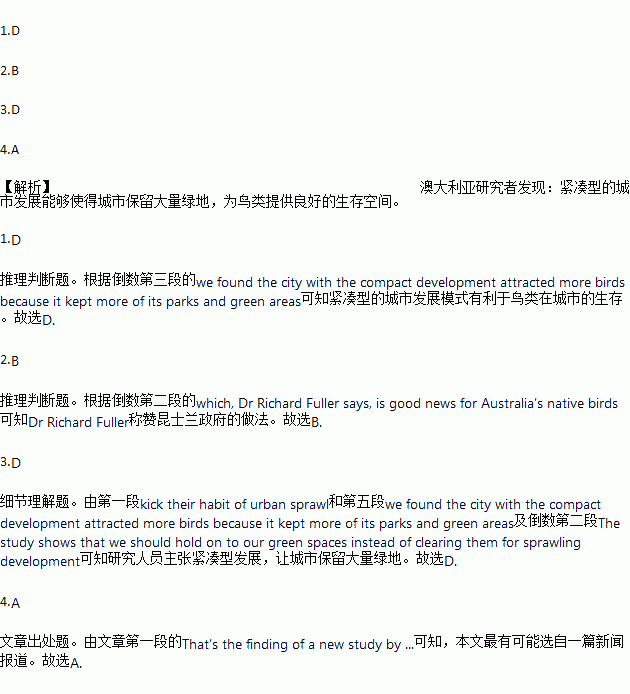题目内容
Australian cities can keep their native wildlife — but only if they can kick their habit of urban sprawl (扩展). That’s the finding of a new study by leading Australian environmental researchers Jessica Sushinsky, Professor Hugh Possingham and Dr. Richard Fuller of The University of Queensland.
“While urban development usually reduces the number of birds in a city, building more compact (紧凑的) cities and avoiding urban sprawl can slow these reductions greatly,” says lead author Jessica Sushinsky. “Compact housing development leaves birds’ homes untouched, leading to fewer losses of birds.”
The researchers surveyed native and wild birds in Brisbane’s urban areas, including living and industrial areas, public parks and gardens, major roadways and airports. They then used statistical modeling to find out what will happen to the birds as the city grows. The first setting was compact growth — where multiple homes are built on land that previously had only one house. The second setting was sprawling growth — a familiar pattern where homes are built here and there beyond the city’s current boundaries.
The team’s forecasts showed that a much greater diversity of species was lost over 20 years in the sprawling setting compared to the more compact setting. “Urban sprawl resulted in the disappearance of many urban-sensitive birds — birds that only live in areas where there is native vegetation (植被), such as parklands and woodlands,” Ms. Sushinsky says.
“On the other hand, we found the city with the compact development attracted more birds because it kept more of its parks and green areas.”
Now the Queensland Government has adopted the more compact urban growth strategy, which, Dr. Richard Fuller says, is good news for Australia’s native birds. These birds are environmental specialists — they need a particular environment to do well. “While compact development means smaller backyards, it can also make our entire cities more biodiverse,” according to Dr. Fuller. “The study shows that we should hold on to our green spaces instead of clearing them for sprawling development.”
This is the first time science has modeled the effects of different urban growth strategies on birds, the researchers say. “Statistical models like these are important because they help us to understand the ecological consequences of a particular decision,” says Dr Fuller.
1.Why is compact urban growth better than the sprawling strategy?
A. It makes the cities more beautiful. B. It gives people larger backyards.
C. It is money-saving. D. It is bird-friendly.
2.Dr Richard Fuller thinks the Queensland Government’s action ______.
A. is really brave B. is worth praising
C. has an uncertain future D. should be performed nationwide
3.What can we learn about the study from the passage?
A. It is based on the statistics in the past.
B. It is strongly against urban development.
C. It criticizes the city environment in Brisbane.
D. It suggests leaving more green spaces for birds.
4.Where does the passage probably come from?
A. A news report. B. A travel guide.
C. A health magazine. D. A history book.


 re urging kids to work harder by offering them obvious encouragements.Happy Meals are at the low end of the scale.With the help of businesses, schools are also giving away cars,iPods,seats to basketball games,and—in a growing number of cases—cold,hard cash.The appeal of such programs is obvious,but the consequences of tying grades to goods are still uncertain.It’s been a common tradition in middle-class families to reward top grades with cash as a way to teach that success in school leads to success in life.But for many disadvantaged minority children,the long-term benefits of getting an education are not so clear,according to experts.
re urging kids to work harder by offering them obvious encouragements.Happy Meals are at the low end of the scale.With the help of businesses, schools are also giving away cars,iPods,seats to basketball games,and—in a growing number of cases—cold,hard cash.The appeal of such programs is obvious,but the consequences of tying grades to goods are still uncertain.It’s been a common tradition in middle-class families to reward top grades with cash as a way to teach that success in school leads to success in life.But for many disadvantaged minority children,the long-term benefits of getting an education are not so clear,according to experts.